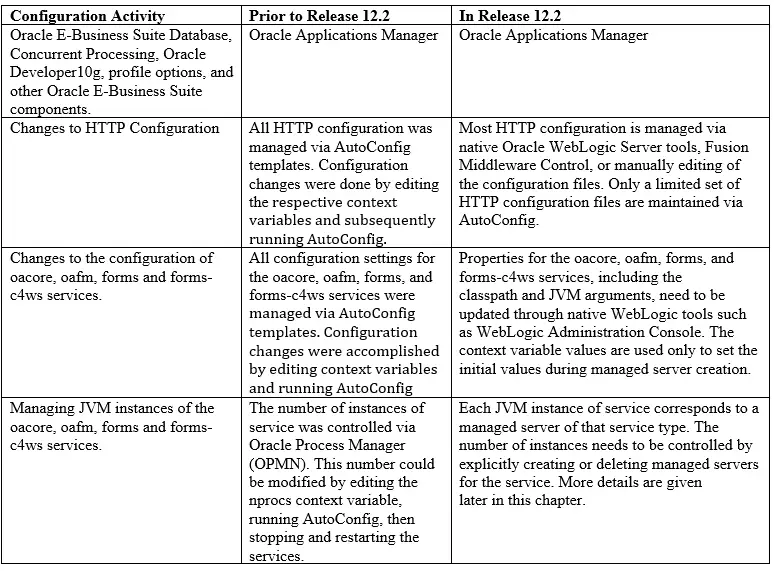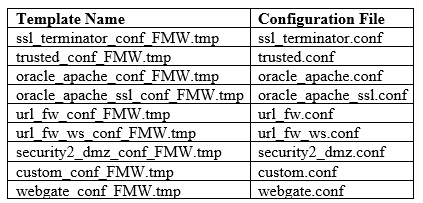- With Oracle E-Business Suite Release 12.2, OC4J has been replaced with Oracle WebLogic Server. This has resulted in a reduced role for AutoConfig in R12.2 in the configuration of the Oracle HTTP Server and the oacore, oafm, forms, and forms-c4ws services. This article talks about changes in Autoconfig R12.2
- Up to and including Oracle E-Business Suite Release 12.1.3, AutoConfig was used to manage the entire Oracle HTTP Server configuration and OC4J instance configuration.
- In Oracle E-Business Suite Release 12.2, it manages only a part of the Oracle HTTP Server configuration. It also only partially manages the configuration of the oacore, oafm, forms, and forms-c4ws services. The remaining scope of AutoConfig remains the same as prior to Oracle E-Business Suite Release 12.2.
About Oracle E-Business Suite Release 12.2 Application Technology Stack
Oracle E-Business Suite Release 12.2 introduced Oracle WebLogic Server (WLS) as part of the application tier technology stack, deploying a dedicated WLS domain with associated clusters of managed servers that include:
- oacore – provides core functionality in EBS application tier Java code, including OAF-based functionality for EBS products
- oafm – supports web services, Secure Search, and Oracle Transport Agent
- forms – provides Oracle forms functionality
Following are the key configuration changes in Autoconfig R12.2

How the httpd configuration is managed in R12.2
In Oracle E-Business Suite Release 12.2, some Oracle HTTP Server configurations and WebLogic configurations are managed via AutoConfig while some are managed natively via Fusion Middleware Control and WebLogic Server Administration Console. A new mechanism has been introduced to keep the context variables and the OHS configuration parameters (where applicable) in synchronization. This mechanism is called the ‘feedback loop’.

Updating AutoConfig-Managed Oracle HTTP Server Configurations in R12.2
The table below shows the Oracle HTTP Server configuration templates that are managed by AutoConfig in Oracle E-Business Suite Release 12.2. The configurations defined in these files can be customized by customizing the templates.

Updating Seeded Oracle HTTP Server Configurations
- During the creation of the Oracle HTTP Server instance, AutoConfig performs the first instantiation of configuration files such as httpd.conf and mod_wl_ohs.conf. After the installation or upgrade to Release 12.2 is complete, seeded Oracle HTTP Server configurations are generally managed via Fusion Middleware Control. In certain specific cases, however, manual editing of the configuration files may be needed: this will be advised separately where required.
- When modifying Oracle HTTP Server protocols or port numbers, these values must be updated in both the context file as well as in the configuration files. This is to ensure that the new values are updated in the AutoConfig-managed database profile values as well.
To modify HTTP server protocols or port numbers, perform the following steps on the run file system:
- Log in to Oracle Fusion Middleware Control Console.
- Select Web Tier Target under EBS Domain.
- Select Administration> Advanced Configuration.
- Edit the relevant file to update the respective HTTP configuration parameter value.
- Run the following command on all application tier nodes:
$ perl <AD_TOP>/bin/adSyncContext.pl contextfile=<CONTEXT_FILE>
Run AutoConfig on all application tier nodes.
How the oacore, forms, and oafm configuration are done in R12.2
The weblogic-managed server is added and deleted as per the below-given articles
How to add the manage server in R12.2
How to delete the manage server in R12.2
General Autoconfig information which is the same as pre-R12.2
Autoconfig in Oracle R12
How to run Autoconfig in parallel
oracle apps autoconfig template file location
What is FND_OAM_CONTEXT_FILES used for? All about it
Articles you must read on R12.2
Service Group changes in R12.2
adopmon and adopreports utility R12.2.5
How to re-attach 12.2 E-Business Oracle Homes to the central inventory
Isolating post-upgrade concurrent programs to a separate manager queue in R12.2
Articles you must read on Oracle sql
How to work with date in Oracle sql
Top 40 Oracle sql interview questions
Things you need to know about Oracle SQL developer
how to write sql queries
